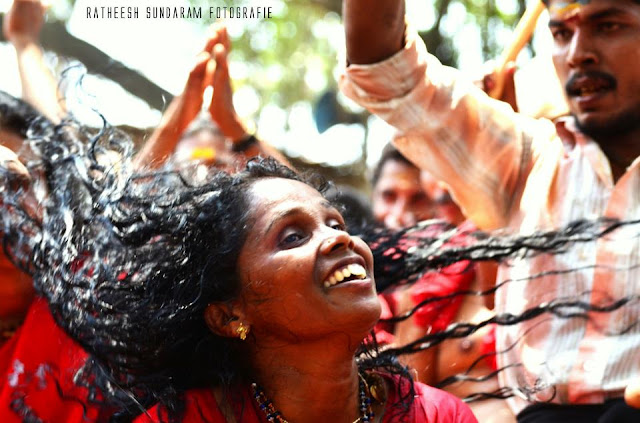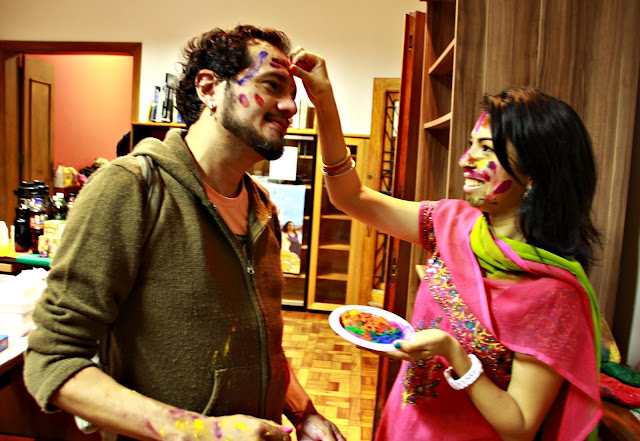O Templo Kodungallur Bhagavathy, acredita-se ter sido construído durante o reinado do rei Chera, Querã Senkuttuvan. É famoso por seu festival Bharani e Thalappoli. O templo exige que o peregrino leve pimenta e açafrão em pó como uma das oferendas à divindade.

Bharani festival acontece no Templo Bhagawati Kodungallur durante um mês de festividades do asterism Bharani no mês de Aquário a sete dias após a asterism Bharani no mês de Peixes. Tradicionalmente, o templo (especialmente durante o festival Bharani) tem sido associado com sacrifícios de animais. O sangue do sacrifício usado para ser derramado sobre duas st
queridos no prakaram (recintos fechados de um templo), mas esses costumes foram abolidos no século 20. O destaque do festival é a maior congregação de oráculos (orVellichapads Komarams) no dia Theendal Kavu. Vestida de vermelho, com cabelo solto, brandindo suas espadas homens e mulheres Komarams criam uma atmosfera elétrica.
Os oráculos realizam uma corrida louca em torno do templo. Eles atiram objetos no interior do templo, principalmente varas que significa a Kavutheendal. Os oráculos também cantam várias músicas que estão associadas com a lenda da Deusa e aqueles associados com a terra a cultura agrícola, e sua mãe.
Outro destaque é o arremesso de abusos na divindade - conhecido localmente como Kodungallur Bharani Pattu. A letra da música contém palavras principalmente sexualmente explícitas - a maioria dos quais são abusivos da natureza.
Isto é seguido por um ritual de purificação no dia após Meena Bharani festival quando o templo é fechado por quase uma semana.
Kodungallur Bhagavathy Templo é o nome popular do templo, o nome original do templo é o Sri Kurumba Devi Temple.
Simbolicamente o festival é dedicado para a energia bruta e indomável - que também oferece uma oportunidade para as seções reprimidas na sociedade para desabafar sua raiva. Acredita-se que Devi aceita todas as suas frustrações e raiva.
Localizado no município de Kodungallur (Malayalam:Cranganore) no distrito de
Thrissur, estado de Kerala, na Índia, na costa de Malabar.
Este festival realizada no dia 24 25 26 - 2012
Texto e Fotos by Ratheesh Sundaram.
Tradução em portugues: Elza Cohen (via google translater)











- It is believed to have been constructed during the reign of Chera King, Cheran Senkuttuvan. It is famous for its Bharani and Thalappoli festival. The temple requires the pilgrim to carry pepper and turmeric powder as one of the offerings to the deity.
- Bharani festival: The Bharani festival at the Kodungallur Bhagawati temple is a month of festivities of the Bharani asterism in the month of Aquarius to seven days after the Bharani asterism in the month of Pisces. Traditionally, the temple (especially during the Bharani festival) has been associated with animal sacrifices. The blood of the sacrificed used to be
 spilled over two st
spilled over two st
ones in the prakaram(closed precincts of a temple), but these customs have been abolished in the 20th century.
The highlight of the festival is the largest congregation of oracles (Komarams orVellichapads) on the Kavu Theendal day. Dressed in red, with untied hair, brandishing
their swords both men and women Komarams create an electric atmosphere.
their swords both men and women Komarams create an electric atmosphere.
The oracles perform a mad run around the temple. They throw objects inside the temple mainly sticks which signifies the Kavutheendal. The oracles also sing numerous songs that are associated with the legend of the Goddess and those associated with farming, culture and mother earth.
Another highlight is the hurling of abuses at the deity – locally known as Kodungallur Bharani Pattu. The lyrics of the song contain mostly sexually explicit words – most of which are abusive of nature.
This is followed by a purification ritual on the day after Meena Bharani festival. The temple is the closed for nearly a week.
Symbolically the festival is dedicated to the raw and untamed energy – it also provides an opportunity to the repressed sections in the society to vent their anger. It is widely believed that Devi accepts all their frustrations and anger.
The municipality of Kodungallur (Malayalam:കൊടുങ്ങല്ലൂര്, anglicised name: Cranganore) is located in the
Thrissur District in the state of Kerala,India on the Malabar Coast. Kodungallur is located 29 km northwest of the city Kochi and 38 km southwest of the city Thrissur, by the National Highway 17.
This festival held on march 24 25 26 - 2012






























































